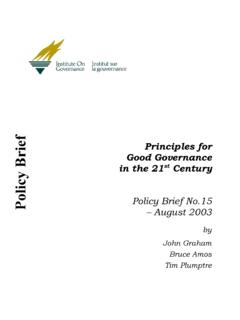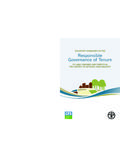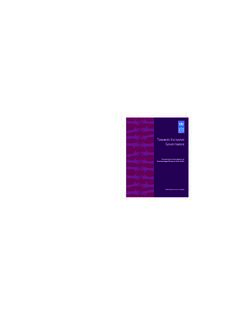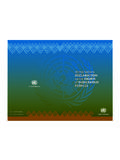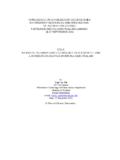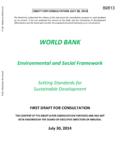Transcription of A SPECIAL REPORT Canada’s Emerging Indigenous Rights ...
1 Canada s Emerging Indigenous Rights Framework: A Critical Analysis 1 Canada s Emerging Indigenous Rights Framework: A Critical Analysis by HAYDEN KING and SHIRI PASTERNAKA SPECIAL REPORT JUNE 05, 20182 Yellowhead InstituteAbstractThe REPORT analyzes the substantial changes to Indigenous policy and legislation in Canada, which are coalescing around the current Liberal Government s proposed Indigenous Rights , Recognition and Implementation Framework legislation. The Prime Minister has announced that the legislation will be introduced sometime in 2018, yet, there is little transparency in the process or accessible information for communities on these dramatic changes.
2 Our analysis considers the Emerging Rights Framework from three perspectives : Relationship Reform charts how the machiner y of government is changing, from the creation of new federal departments on Indigenous issues to nation-to-nation bilateral tables. Policy Reform considers the new direction on self-government, fiscal relations, and land claims policies. Legislative Reform examines impending legislation currently before parliament, including changes to impact assessment regulations and implementation of the UN s Declaration on the Rights of Indigenous People. Our analysis reveals that the Rights Framework guides First Nations towards a narrow model of self-government outside of the Indian Act, premised on devolution of program and service delivery, fiscal mechanisms that do not address land Rights but focus on accountability, a piecemeal approach to Aboriginal title, and an ongoing neglect of treaty obligations or expansive First Nation jurisdiction generally.
3 KeywordsRights Framework, Indian Act, Self-Government, Section 35, Fiscal Relations, Title, Reconciliation, INAC Split, Land Claims, Justin TrudeauAcknowledgementsThis REPORT and the Yellowhead Institute itself is not possible without the support of the Faculty of Arts at Ryerson University. A SPECIAL thanks to our colleagues in the Dean s office including Dean Pam Sugiman, Sharmaine MacKenzie, Allison Urowitz, Suelan Toye, Julia Davydova and Greg Fiordo. We are also indebted to our Board of Advisors for their guidance and feedback, and to the thirty policy and legal analysts who attended a two-day meeting on the Emerging Rights Framework held at Ryerson University in March 2018.
4 Thanks also to government officials, expert panel members, and First Nation citizens, activists and leaders who took time to share their insights. We are grateful to our research assistants Athena Bedassigae-Pheasant, Sarah Dennis, Graham Reeder and Sue Collis, copy editor Robyn Letson, Stan Williams for his photography, Anita Sekharan for web support and design, Elise Cotter in Ryerson media relations. And to Yumi Numata for communications support and project management, thank you. FRONT COVER IMAGE BY STAN WILLIAMSA Note on AuthorshipThis REPORT is primarily the work of the Directors of the Yellowhead Institute, Hayden King and Shiri Pasternak.
5 The questions guiding our analysis and shaping our critique arise from a collaborative process that drew from a wide range of participants, including policy analysts, lawyers, consultants, academics, journalists and community organiz-ers, many representing First Nations from across the country, some of whom participated in a two-day meeting organized by the Yellowhead Institute at Ryerson University, March 17-18, REPORT is licensed under a Creative Commons Attribution-NonCommercial Canada License. Canada s Emerging Indigenous Rights Framework: A Critical Analysis 3 TABLE OF CONTENTSE xecutive Summary 4 Introduction: The Indigenous Rights Framework 6 Part One.
6 Relationship Reform 8a. Principles Respecting the Government of Canada s Relationship with Indigenous Peoples 8b. The Nation-to-Nation MOU 8c. The INAC Split, Constitutional Obligations & Self-Government 9 Part Two: Policy Reform 12a.
7 Re-Constituting Nations : The New/Old Self-Government Model 12 Constitutional Development & Capacity Building 12 Aggregation / Reconstituting Nations 12 Self-Government Lite 13b.
8 Fiscal Relations & The New Accountability 15A First Nation Finance Regime 15 Fiscal Relations and Modern Treaty Self-Government 16 Fiscal Relations and Indian Act Bands 17c.
9 Aboriginal Title, Comprehensive Claims & Rights Recognition Tables 17 Concerns with the Process 18 Incremental & Sectoral Approaches to Aboriginal Title 19 The Future of Aboriginal Title
10 20 Part Three: Legislative Reform 21a. Sixteen New Pieces of Legislation 21 Cabinet Committee to Decolonize Canada s Laws 21 Consent & The New Regulatory Regime 21 Harmony with UNDRIP: The Saganash Bill 24b.
